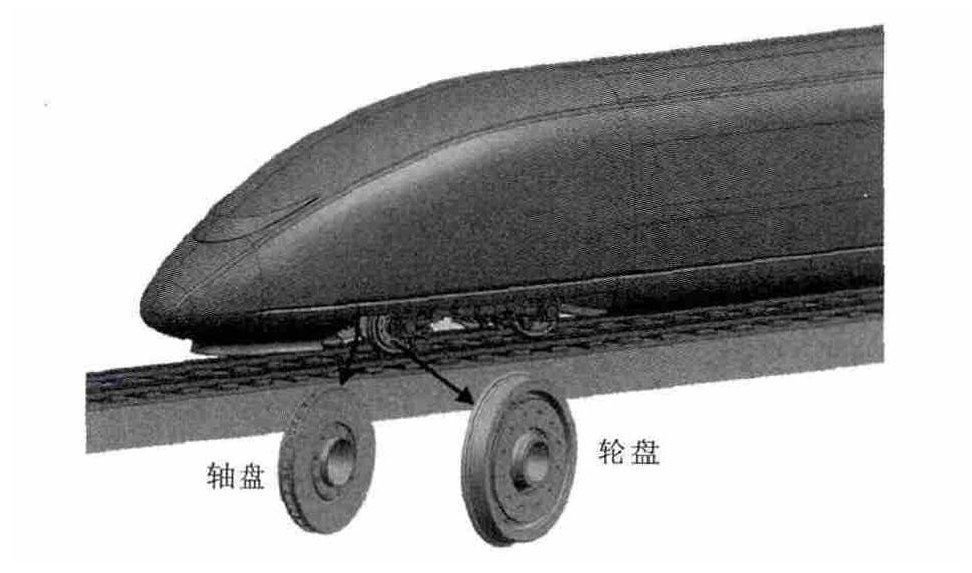Air-pumping effect analysis for brake disc of high-speed train
-
摘要: 为研究列车运行过程中制动盘泵风特性, 建立了列车、轨道、制动盘及其附近空气流场的有限元模型, 采用动网格流固耦合仿真方法, 计算了制动盘泵风功耗, 分析了制动盘泵风对牵引功率的影响。以运行速度为300km·h-1的4动4拖8辆编组列车为例, 进行了制动盘泵风效应的仿真与对比分析。分析结果表明: 制动盘泵风功耗与列车运行速度成正比, 每辆车泵风功耗为5470kW, 泵风阻力矩与制动盘安装位置无关, 主要受制动盘转动速度影响; 随列车运行速度的提高, 制动盘泵风功耗占比略有下降, 当列车运行速度由200km·h-1提高为400km·h-1时, 制动盘泵风功耗占比由12%降低为8%;封堵制动盘进风口可以降低泵风功耗的影响, 当列车运行速度为300km·h-1时, 封堵制动盘进风口后, 列车制动盘泵风功耗由原来的489 kW降低为68kW, 泵风功耗占基本阻力功耗的比例由原来的9.0%降低为1.3%, 改善效果显著。可见, 从泵风功耗角度探索优化高速列车制动盘散热筋结构具有较大的现实意义。Abstract: To study the air-pumping characteristics of brake disc during train operation, the finite element models including vehicle, rail, brake disc and related air flow field were put forward. The air-pumping power consumption of brake disc was calculated, and its effect on traction power was analyzed by using dynamic grid and flow-solid conjugation simulation method.Taking a 8-unit high-speed train composed of 4 motor cars and 4 trailers running at 300 km·h-1 as an example, the air-pumping effect of brake disc was simulated and compared.Simulation result indicates that the air-pumping power consumption of brake disc is in proportion to train running speed.The air-pumping power consumption of each car is about 54-70 kW.The air-pumping torque, independent of installation position of brake disc, is mainly influenced by the rotational velocity of brake disc.The proportion of air-pumping power consumption of brake disc reduces with the increase of train running velocity.When train running velocity increases from 200 km·h-1 to 400 km·h-1, the proportion of air-pumping power consumption reduces from 12% to 8%. Blocking air from the inlets of brake discs is helpful to reduce the influence of air-pumping power consumption.Taking the train running at 300 km·h-1 as an example, when the inlets of brake discs are blocked, the air-pumping power consumption of brake disc reduces from 489 kW to 68 kW, the basic resistance power consumption consumed by air-pumping power consumption reduces from 9.0% to 1.3%, so the method is effective.Obviously, it has greater realistic meanings for the cooling rib structure optimization of brake disc of high-speed train in considering the air-pumping power consumption issue.
-
表 1 泵风阻力矩
Table 1. Air-pumping torques

表 2 泵风阻力矩对比
Table 2. Comparison of air-pumping torques

-
[1] RAGHUNATHAN R S, KIM H D, SETOGUCHI T. Aerodynamics of high-speed railway train[J]. Progress in Aerospace Sciences, 2002 (38): 469-514. [2] KHIER W, BREUER M, DURST F. Flow structure around trains under side wind condition: a numerical study[J]. Computers and Fluids, 2000, 29 (2): 179-195. doi: 10.1016/S0045-7930(99)00008-0 [3] 陈南翼, 张健. 高速列车空气阻力试验研究[J]. 铁道学报, 1998, 20 (5): 40-46. doi: 10.3321/j.issn:1001-8360.1998.05.007CHEN Nan-yi, ZHANG Jian. Experimental investigation of aerodynamic drag of high speed train[J]. Journal of the China Railway Society, 1998, 20 (5): 40-46. (in Chinese). doi: 10.3321/j.issn:1001-8360.1998.05.007 [4] 苗秀娟, 田红旗, 高广军. 峡谷风对桥梁上列车气动性能的影响[J]. 中国铁道科学, 2010, 31 (6): 63-67. https://www.cnki.com.cn/Article/CJFDTOTAL-ZGTK201006012.htmMIAO Xiu-juan, TIAN Hong-qi, GAO Guang-jun. The influence of the gorge wind on the aerodynamic performance of the train on bridge[J]. China Railway Science, 2010, 31 (6): 63-67. (in Chinese). https://www.cnki.com.cn/Article/CJFDTOTAL-ZGTK201006012.htm [5] 姚拴宝, 郭迪龙, 杨国伟, 等. 高速列车气动阻力分布特性研究[J]. 铁道学报, 2012, 34 (7): 18-23. doi: 10.3969/j.issn.1001-8360.2012.07.003YAO Shuan-bao, GUO Di-long, YANG Guo-wei, et al. Distribution of high-speed train aerodynamic drag[J]. Journal of the China Railway Society, 2012, 34 (7): 18-23. (in Chinese). doi: 10.3969/j.issn.1001-8360.2012.07.003 [6] 郑循皓, 张继业, 张卫华. 高速列车转向架空气阻力的数值模拟[J]. 交通运输工程学报, 2011, 11 (2): 45-51. doi: 10.3969/j.issn.1671-1637.2011.02.008ZHENG Xun-hao, ZHANG Ji-ye, ZHANG Wei-hua. Numerical simulation of aerodynamic drag for high-speed train bogie[J]. Journal of Traffic and Transportation Engineering, 2011, 11 (2): 45-51. (in Chinese). doi: 10.3969/j.issn.1671-1637.2011.02.008 [7] 祝华. SAB Wabco公司开发出新型制动盘[J]. 国外铁道车辆, 2005, 42 (3): 42. https://www.cnki.com.cn/Article/CJFDTOTAL-GWTD20050300F.htmZHU Hua. New braking disc designed by SAB Wabco[J]. Foreign Rolling Stock, 2005, 42 (3): 42. (in Chinese). https://www.cnki.com.cn/Article/CJFDTOTAL-GWTD20050300F.htm [8] 左建勇, 吴萌岭, 罗卓军. 考虑车下环境的高速动车组空气流场数值仿真[J]. 同济大学学报: 自然科学版, 2013, 41 (11): 1717-1720, 1750. doi: 10.3969/j.issn.0253-374x.2013.11.018ZUO Jian-yong, WU Meng-ling, LUO Zhuo-jun. Simulation on air flow field of high-speed train concerning the environment under train[J]. Journal of Tongji University: Natural Science, 2013, 41 (11): 1717-1720, 1750. (in Chinese). doi: 10.3969/j.issn.0253-374x.2013.11.018 [9] PALMER E, MISHRA R, FIELDHOUSE J. An optimization study of a multiple-row pin-vented brake disc to promote brake cooling using computational fluid dynamics[J]. Proceedings of the Institution of Mechanical Engineers, Part D: Journal of Automobile Engineering, 2009 (223): 865-875. [10] YILDIZ Y, DUZGUN M. Stress analysis of ventilated brake discs using the finite element method[J]. International Journal of Automotive Technology, 2010, 11 (1): 133-138. [11] SIROUX M, HARMAND S, DESMET B. Experimental study using infrared thermograhy on the convective heat transfer of a TGV brake disc in the actual environment[J]. Optical Engineering, 2002, 41 (7): 1558-1564. [12] CHUNG W S, JUNG S P, PARK T W. Numerical analysis method to estimate thermal deformation of a ventilated disc for automotives[J]. Journal of Mechanical Science and Technology, 2010, 24 (11): 2189-2195. [13] HWANG P, WU X. Investigation of temperature and thermal stress in ventilated disc brake based on 3D thermo-mechanical coupling model[J]. Journal of Mechanical Science and Technology, 2010, 24 (1): 81-84. [14] PEVEC M, POTRC I, BOMBEK G, et al. Prediction of the cooling factors of a vehicle brake disc and its influence on the results of a thermal numerical simulation[J]. International Journal of Automotive Technology, 2012, 13 (5): 725-733. [15] CALINDO-LOPEZ C H, TIROVIC M. Maximising heat dissipation from ventilated wheel-hub-mounted railway brake discs[J]. Proceedings of the Institution of Mechanical Engineers, Part F: Journal of Rail and Rapid Transit, 2013, 227 (3): 269-285. -





 下载:
下载:











